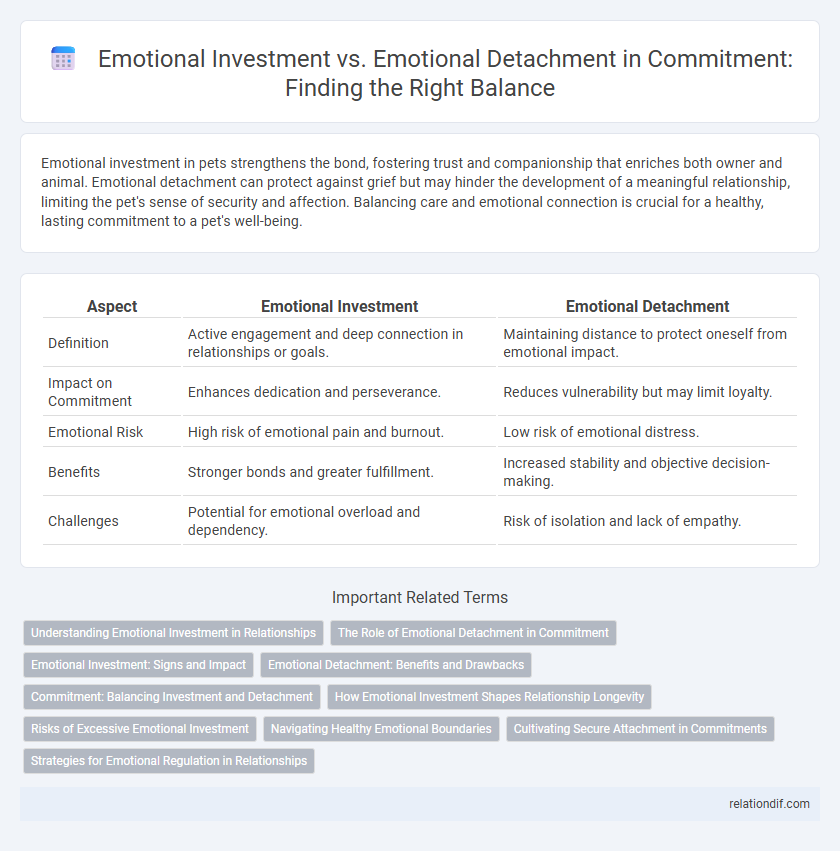Emotional investment in pets strengthens the bond, fostering trust and companionship that enriches both owner and animal. Emotional detachment can protect against grief but may hinder the development of a meaningful relationship, limiting the pet's sense of security and affection. Balancing care and emotional connection is crucial for a healthy, lasting commitment to a pet's well-being.
Table of Comparison
| Aspect | Emotional Investment | Emotional Detachment |
|---|---|---|
| Definition | Active engagement and deep connection in relationships or goals. | Maintaining distance to protect oneself from emotional impact. |
| Impact on Commitment | Enhances dedication and perseverance. | Reduces vulnerability but may limit loyalty. |
| Emotional Risk | High risk of emotional pain and burnout. | Low risk of emotional distress. |
| Benefits | Stronger bonds and greater fulfillment. | Increased stability and objective decision-making. |
| Challenges | Potential for emotional overload and dependency. | Risk of isolation and lack of empathy. |
Understanding Emotional Investment in Relationships
Emotional investment in relationships involves a deep connection where feelings, trust, and time are willingly shared, fostering intimacy and mutual support. This investment contrasts with emotional detachment, which creates distance and limits vulnerability, hindering authentic bonding. Understanding the balance between commitment and emotional boundaries is crucial for sustaining healthy, resilient partnerships.
The Role of Emotional Detachment in Commitment
Emotional detachment plays a crucial role in commitment by allowing individuals to maintain clarity and objectivity, preventing overwhelming feelings from clouding judgment. It enables partners to navigate challenges calmly and make rational decisions that support long-term stability. Balancing emotional investment with measured detachment fosters resilience and sustainable dedication in relationships.
Emotional Investment: Signs and Impact
Emotional investment in relationships is characterized by consistent support, open communication, and genuine empathy, fostering deeper connection and trust. Signs include prioritizing your partner's well-being, sharing vulnerabilities, and actively resolving conflicts to strengthen the bond. This level of commitment enhances emotional intimacy, reduces misunderstandings, and promotes long-term relationship satisfaction.
Emotional Detachment: Benefits and Drawbacks
Emotional detachment in commitment allows individuals to maintain objectivity and reduce vulnerability to emotional pain, enhancing decision-making and stress management. However, excessive detachment can hinder deep connections and lead to feelings of isolation or misunderstanding in relationships. Balancing emotional detachment is crucial for sustaining healthy commitments while protecting personal well-being.
Commitment: Balancing Investment and Detachment
Commitment requires a careful balance between emotional investment and detachment to foster sustainable relationships and personal well-being. Excessive emotional investment can lead to vulnerability and burnout, while excessive detachment may cause disconnection and lack of trust. Effective commitment involves measured engagement that protects individual boundaries while nurturing meaningful connections.
How Emotional Investment Shapes Relationship Longevity
Emotional investment significantly influences relationship longevity by fostering trust, intimacy, and mutual understanding between partners. Higher levels of emotional engagement promote resilience during conflicts and enhance satisfaction, leading to stronger, more enduring bonds. Conversely, emotional detachment can create barriers to effective communication and erode the foundation of long-term commitment.
Risks of Excessive Emotional Investment
Excessive emotional investment in commitment can lead to vulnerability, increased stress, and potential loss of self-identity. Over-attachment often results in difficulty setting healthy boundaries, causing emotional exhaustion and impaired decision-making. Recognizing the risks of emotional over-involvement is crucial for maintaining balanced relationships and personal well-being.
Navigating Healthy Emotional Boundaries
Navigating healthy emotional boundaries involves balancing emotional investment with emotional detachment to foster commitment without losing personal well-being. Establishing clear boundaries prevents emotional burnout and promotes mutual respect in relationships by allowing vulnerability while maintaining self-protection. Effective emotional management enhances trust and long-term connection, essential components of a committed partnership.
Cultivating Secure Attachment in Commitments
Cultivating secure attachment in commitments involves fostering consistent emotional investment that builds trust and resilience over time. Emotional investment strengthens bonds by encouraging vulnerability and open communication, whereas emotional detachment often leads to insecurity and relational instability. Prioritizing secure attachment enhances relational satisfaction and long-term commitment sustainability.
Strategies for Emotional Regulation in Relationships
Effective strategies for emotional regulation in relationships emphasize balancing emotional investment and detachment by fostering self-awareness and communication skills. Techniques such as mindfulness meditation, cognitive reframing, and setting healthy boundaries enhance emotional resilience and prevent overdependence. Consistent practice of empathy and active listening promotes mutual understanding, reducing conflicts and strengthening commitment.
emotional investment vs emotional detachment Infographic

 relationdif.com
relationdif.com